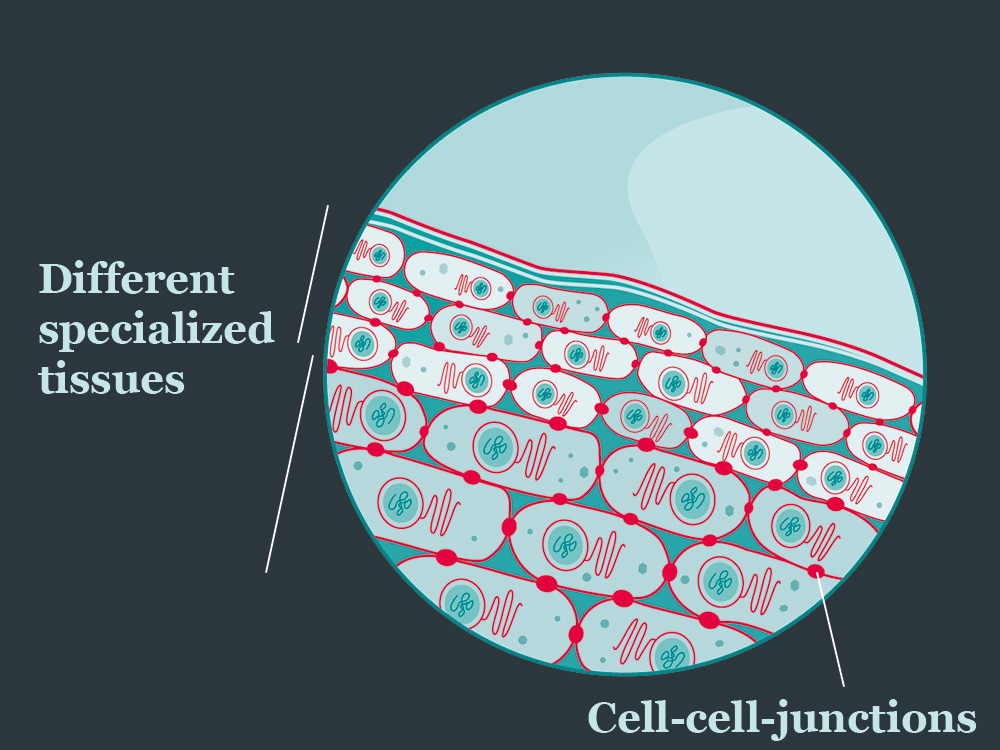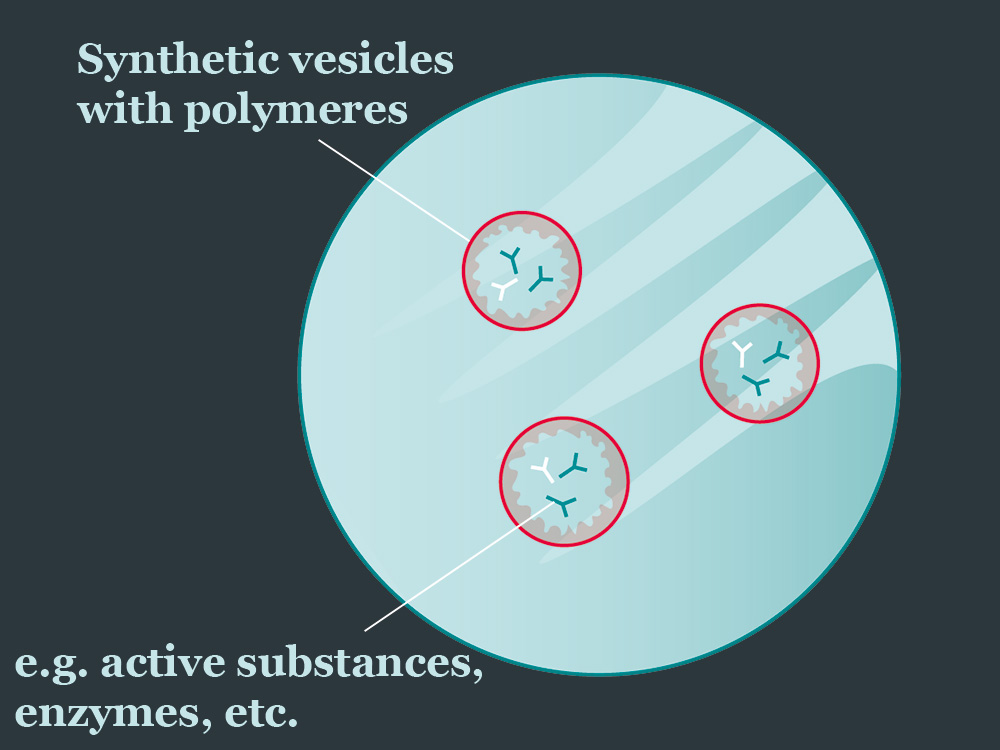No life without boundaries.
Texts: Yvonne Vahlensieck; Graphic art: Marina Bräm
Biological membranes were a key prerequisite for the first living beings. Then, cooperation across boundaries paved the way for more complex forms of life.
Starting around 4.5 billion years ago
Primordial soup: Organic substances such as amino acids and lipids form the foundation of life. Just how and where they first arose is a hotly contested issue – were they created by UV radiation, volcanic gases or asteroid impacts? Did it happen in a slimy primordial soup, inside rocks or near hot hydrothermal vents deep in the ocean?
Around 4.3 billion years ago
Protocells: Due to their water-repelling, or hydrophobic, properties, lipids group together spontaneously to form vesicles, or sacs enclosed in a membrane. Any organic substances inside that membrane react with one another, and the products of those reactions build up. Over time, these reactions develop into the processes necessary for life.
Around 4 billion years ago
Single-celled organisms without organelles or nuclei (procaryotes): These cells now exhibit the properties of life. They reproduce by division and pass on their hereditary material. Proteins embedded in the membrane import and export controlled substances and detect stimuli in the surrounding environment.
Around 2 billion years ago
Cells with organelles (eukaryotes): The cell interior of complex organisms is equipped with more advanced structures, including membrane-encapsuled organelles such as the nucleus, endoplasmic reticulum, Golgi apparatus and mitochondria.
Cooperation despite boundaries.
While the interior of a bacterium resembles an enormous factory in which all biological processes take place, the cells of fungi, plants and animals are divided into numerous specialized workshops. In these separate spaces, known as organelles, different types of work take place. This system has its advantages, says cell biologist Anne Spang from the Biozentrum at the University of Basel: “Certain processes can happen separately, and they don’t interfere with one another.”
A peek through the microscope reveals that in spite of the boundaries between organelles, the cell is bustling with traffic between its different compartments. Tiny sacs, or vesicles, are constantly pinching off from the membranes, traveling through the interior of the cell and merging with other organelles or the cell’s outer membrane. These vesicles transport substances, such as newly produced proteins, to the areas where they are needed. “For a long time, cell biology was focused on these linear transport processes,” says Spang. “Now, it turns out that everything is far more dynamic.”
For example, there are frequent, extremely brief interactions between vesicles and different organelles in which proteins are transferred between compartments. Researchers refer to this process as “kiss and run”.
Around 800 million years ago
Multicellular organisms: Multiple cells combine to form an organism, and specialized cell types and tissues develop to perform specific tasks. To achieve this, the cells must stick together in a stable structure. Internal communication, for example by chemical messengers, is required for the organism to function as a whole.
Cohesion across boundaries.
One important prerequisite for the leap from single-cell organisms to multicellular forms of life was that cells adhere to each other using specialized protein complexes. This contact between cells allows them to communicate and cohere to form contiguous and stable tissues.
“One specialized form of these protein complexes, known as desmosomes, developed rather late in terms of evolution when organisms made the shift from water to land,” says anatomist Volker Spindler from the Department of Biomedicine at the University of Basel. “These structures confer stability to tissues exposed to high levels of mechanical stress, such as the skin.” The effects of a loss of this stability can be seen, for example, in patients with pemphigus, a disease in which the skin begins to blister and slough off. Pemphigus causes the body’s immune cells to attack the desmosomes – and the skin cells lose their cohesion as a result.
Together with his laboratory team, Spindler studies the function of desmosomes in order to lay the groundwork for new treatments. In addition to studying pemphigus, his team also investigates the mechanisms underlying arrhythmogenic cardiomyopathy, a type of heart disease with high mortality. Spindler’s team demonstrated that this disease can also be traced back to malfunctioning desmosomes. “Without cohesion provided by desmosomes, the heart muscle is simply unable to bear the mechanical stress it is exposed to.”
Today
Synthetic vesicles: A tactic that nature has employed for around 4 billion years is now being built by researchers, too. Artificial vesicles are used in medicine, for instance as a protective envelope for mRNA vaccines.
Specialized containers in miniature.
Medications reach their targets in the body more effectively and remain more stable when they are encapsulated in a protective compartment. Researchers today are developing these miniature containers based on models found in nature: Cells use vesicles, for instance, to transport molecules internally or externally. Cornelia Palivan and her team at the Department of Chemistry construct artificial vesicles and design them with advantageous properties: By employing specific polymers, her team can produce optimized vesicles that are more stable and do not aggregate, which makes them even better protective and efficient for medications.
One type of vesicle is specifically made to release the cargo “on command” in response to changes in the pH of the surrounding environment. This is particularly powerful in the development of future cancer treatments because tumor cells have a lower pH than healthy tissue. Another approach involves encapsulating multiple miniature containers containing different enzymes inside another bigger vesicle to create a kind of mini factory. In this manner, simplified natural cascade reactions between the enzymes from the miniature containers can be studied to better understand these processes.
(Text: Angelika Jacobs)
More articles in this issue of UNI NOVA (November 2023).






